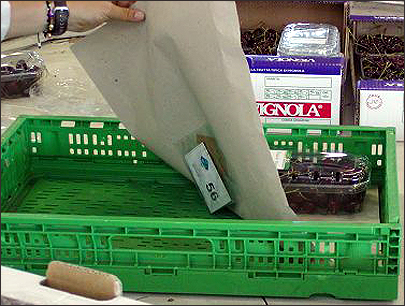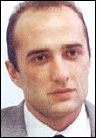The RFID Lab at the University of Parma and several partners have completed a pilot tracking the temperatures of cherries shipped from the field by Apo Conerpo, a producer of fresh fruit, to stores that are part of Nordiconad, a division of the Conad retailing cooperative. The pilot was conducted in the cities of Modena and Albenga, Italy. The aim of the project was to track the storage temperatures of the cherries throughout the entire supply chain, from the producer, where the RFID sensor was activated, to the shop floor, where it was switched off.
“Many cold-chain pilots I’ve heard of cover a single process, such as storage or transportation, but not the whole supply chain,” says Antonio Rizzi, a full professor of industrial logistics and supply-chain management at the Department of Industrial Engineering at the University of Parma. Rizzi is the founder and head of the RFID Lab, which led the project.
The cold-chain pilot was part of the Frutticultura project, headed by the Centro Ricerche Produzioni Vegetali and funded by the Emilia Romagna region. Partners include Apo Conerpo and Nordiconad, which monitored the bins of cherries at two distribution centers and shipped them to six department stores (three in Emilia Romagna and three in Liguria). Italian IT solutions provider Di.Tech, along with the University of Parma, supervised software implementation and data analysis.
The one-month project, timed to coincide with the cherry-harvest season in Italy, concluded in July. During that month, partners tagged approximately 120 reusable plastic containers with custom-designed RFID temperature sensors, called MTSens, provided by Italian company Montalbano Technology (see Pharma Label Maker to Test Tags That Record Temps).
Once the tag was switched on at the grower’s site, the MTSens began collecting temperature data, which was then stored on the tag with corresponding information regarding time. The semi-active, battery-powered tags function at 13.56 MHz and comply with the ISO 15693 standard. Tags were mounted between boxes of cherries and reusable containers, as well as underneath sheets of paper.
Eight desktop USB readers made by FEIG Electronic were employed in the application. One interrogator was used by the producer for activating tags after the cherries were packaged; University of Parma researchers utilized a second for downloading temperature logs; and a third was employed for switching off RFID tags at each of the six stores selling the cherries.
The pilot tracked an average of six cases of cherries shipped daily from the producer to the retailer. Three were sent from the manufacturer to a retailer distribution center in Modena, and three to another in Albenga. The cherries were shipped from the DCs to three stores in each area. When boxes were sold, the retailer used its interrogator to switch off the tags and returned them to the university via express mail. Researchers at the university downloaded data and shipped RFID tags back to the producer for reuse.
As they started to discuss the project, Rizzi recalls, the partners realized they had strict time and budgetary constraints. “We had to be ready for the cherry harvest that was starting in a month and lasted for only a few weeks. After thorough discussions, we decided we did not have enough time and resources to tag products extensively and implement the whole RFID infrastructure required to track automatically the flow of goods throughout the supply chain.”

Therefore, the partners decided to track the temperatures of only a few containers of cherries each day, in an application with few RFID read points. “This gave us a great level of flexibility and agility,” Rizzi says, adding, “we were able to be up and running in a couple of weeks. At the same time, we managed to keep the whole budget below €20,000 [$27,400], including tags, equipment and manpower for data analysis.”
One of the main challenges of the pilot was to be sure tags were not lost, since the RFID-tagged cases had to be shipped from the producer to the proper retailer and DC, and from the DC to the correct store. A total of 200 tags were used during the pilot, and some were lost or broken. More than 65,000 temperature-tracking logs were recorded as the cherries moved along the supply chain.
As a result of the project, the partners learned that cherries were subject to the most erratic storage conditions during the transport phase, and that the transport and storage time for cherries was greater than expected, unveiling bottlenecks in the supply chain.
Moreover, Rizzi notes, a new set of key indicators to assess cold-chain performance was discovered. The pilot allowed the partners to develop a probability model that would be ideal for a company looking to get into the business of certifying the cold chain. Many logistics companies and growers need to document the storage conditions of food for their customers and regulatory authorities. The model uses the data collected via RFID to predict with a certain probability that products have spent no more than a specified number of days in the supply chain, and that they were kept in the proper temperature range.
“Spot checks using RFID can be carried out periodically in order to audit these KPI and take the appropriate corrective actions,” Rizzi says. The methodology, he adds, will be detailed in a scientific paper to be submitted to the international journal of RF technologies. Rizzi’s colleague, Roberto Montanari, and Monica Guizzardi, Apo Conerpo’s chief quality officier, will discuss the learnings from the pilot in detail at RFID Journal LIVE! Europe 2007, RFID Journal’s third annual conference and exhibition in Europe. The event will be held in Amsterdam, Nov. 6-8, 2007.


